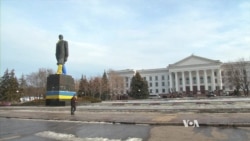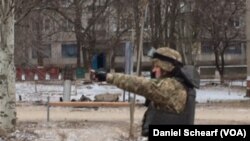While battles rage daily in some parts of eastern Ukraine, not far away -- in areas the government took back from the Russian-backed rebels last summer -- people are doing their best to live normal lives, while keeping a wary eye on the shifting front lines.
In Kramatorsk, a statue of the Russian revolutionary Vladimir Lenin still stands proudly in the main square, but someone has painted his trousers Ukrainian yellow and blue.
Just 100 kilometers to the east, Ukrainians fight Russian-backed rebels. But here, Lenin presides over families trying to keep to their normal routines, taking advantage of a mild winter day to go for an outing.
Still, concern that the rebels could fight their way back to the city is not far from their minds.
“I’m anxious, a little bit anxious. But still, we’re hoping people won’t want them anymore, and won’t let them come back," says Alyona, a homemaker, who brought her daughter to the square for a pony ride on a mild winter day.
“Of course I’m concerned, just like everyone else here," says Anton, an electronics repairman. "I can’t make any predictions. We’re getting too little information. But I hope they will protect us. I will try to help as best I can.”
Traumatized by fighting
Local people have been traumatized by the daily reports from the nearby battlefields, says Alexander Kihtenko, Donetsk regional governor.
“It affected the psychological state of the people very negatively," Kihtenko says.
"People are almost constantly under the threat of shelling, under threat of losing their homes, their relatives and friends. Now, the citizens of Donetsk region want only one thing. They want peace,” he says.
And they're just trying to find some peace when they can.
However, Ukrainian officials say these people will put up stiff resistance if the rebels and the Russians come to big cities like Kramatorsk, which has a population of more than 150,000.
Still, here, like farther east, not everyone opposes the rebels. There is considerable pro-Russian sentiment, and an overlay of Soviet-built factories and symbols of a time when Ukraine and Russia were both part of the Soviet Union.
Pro-Russian sentiment
Forty kilometers closer to the battlefront, in the town of Artemivsk, a group of women protested the Ukrainian government’s conscription program. They don’t want their husbands and sons to fight against Russia, they say. One says if people in Kyiv want to fight Russia, they should send their sons to do it.
Those women are not alone, but their views appear to be in the minority. Most people in government-held areas don’t want the rebels to return.
Vasily, a retired pipefitter, says, "When [the rebels] left, it was horrible. Now, it’s very good. May they never return!"
Alyona, the homemaker, says, “In the past, they had some support from people. Now people have seen that it’s bad, that war means destruction, disaster, tears. We hope that it’s just threats and it won’t become reality.”
That’s the hope. But as convoys head east from the city, and the dead and wounded come back, it’s difficult to know how many more peaceful Saturdays there will be for pony rides in the square.
Read about a rocket attack in Kramatorsk, view a related photo gallery by VOA's Daniel Schearf.









